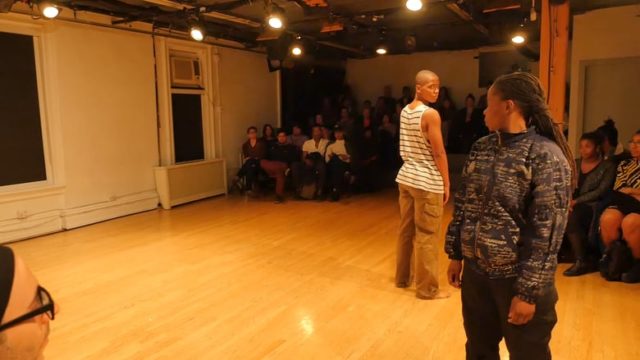
Ni’Ja Whitson and Kirsten Flores-Davis in “A Meditation on Tongues”
Ni’Ja Whitson: A Meditation On Tongues
American Realness
Abrons Arts Center
466 Grand St
New York, NY
January 7-9, 2017
Sitting in Ni’Ja Whitson’s A Meditation On Tongues Sunday night, I couldn’t shake the feeling that I was watching ghosts. Part of the American Realness festival, their moving performance (Note: Ni’Ja identifies as gender non-specific and prefers the pronouns “they/their”) reinterpreted Marlon Riggs’s seminal 1989 film Tongues Untied, which explored the fraught intersection of black and gay male identity during the critical years of the HIV/AIDS pandemic.
More than an ode to an important cultural object, A Meditation On Tongues seemed like a raising of the dead. By appropriating the film’s dialogue and imagery, Whitson and their fellow performers channeled the lost generation of black gay men depicted in the film through the bodies of today’s gender nonconforming and queer artists of color. This allowed Whitson to not only address a wider range of gender presentations, but also powerfully represent the ongoing legacy of Riggs and other late poets, writers and dancers in Tongues Untied.
The performance began unexpectedly. As the audience waited for the theater doors to open, a thin man in a tracksuit inconspicuously walked through the crowd and plugged his iPhone into a boombox hidden below the lobby’s water fountain. Turning on blaring, pumping electronica, he began to vogue.
Only then, did I realize this was Jason Anthony Rodriguez, better known as Slim Ninja. Part of the iconic House of Ninja, Ninja duck-walked through the crowd, landing spins, dips and clicks. As he worked the room, Ninja bore more than a passing resemblance to his ballroom foremother Willi Ninja, who appeared in Tongues Untied. Slim Ninja, walking the runway, became an uncanny physical manifestation of Willi Ninja’s legacy and the lineage of the House of Ninja.
Ninja’s performance stopped almost as suddenly as it started. He led the audience into a narrow hallway backstage where the smell of incense hit me almost immediately. The darkened cement brick-lined space featured an altar to Riggs, Willi Ninja, poet Essex Hemphill and other men who died from complications from AIDS. With candles, photographs and projections from the film, it was touching and, like most memorials, particularly unexpected ones, a little spooky.
Joined by Whitson and their NWA Project company member Kirsten Flores-Davis, Ninja stopped the audience in a blue-lit part of the hallway directly in front of the doors to the theater. There, the trio reperformed a lesson in the intricacies of snapping like a diva–perhaps the most well-known scene from Tongues Untied, which, thanks to YouTube, went viral long after Riggs’s death in 1994. After repeating, “Precision, poise, placement,” the performers finally guided the audience into the theater.
The rest of the show continued as a duet between Whitson and Flores-Davis. Starting with the chant “Brother to brother” from the beginning of the movie, the performance featured layers of spoken word, dance, exhausting physical choreography, and sound and video projections, mimicking the multiplicity of voices in the film.
What allowed A Meditation On Tongues to avoid becoming a heavy-handed reenactment was its strenuous choreography. For example, in one scene, Whitson and Flores-Davis deliver a speech about the inability to “go home” as a black gay man. Here, home not only means the family, but also the black community at large. As one performer spoke, the other ran across the stage, up the stairs, through the balcony and back down again. This occurred over and over as the performers switched roles of speaker and runner. The duo became more exhausted and out of breath as the monologue continued, representing the physical and mental toll of alienation.
With this emphasis on their bodies and movement, Whitson and Flores-Davis equate the experiences of men, as described in the film, with those of gender nonconforming and queer individuals of color. For better or for worse, Tongues Untied solely focuses on gay black men. It even ends with the phrase “Black Men Loving Black Men Is A Revolutionary Act” emblazoned on the screen. By appropriating Riggs’s script and using their own gender nonspecific and nonconforming bodies as a medium, Whitson significantly reconfigures and expands the reach of Riggs’s film to speak to the experiences of a more fluid range of masculine gender presentations.
The performers’ manipulation of their physicality is also excruciatingly visceral. Several times, the performers audibly mimed choking or struggling to speak. Looking at other audience members, I could see winces of pain as Flores-Davis, with their mouth-open and hands on their neck, gagged and gasped for breath while writhing on the floor. Rather than just relying on the film’s description of silence (“Silence is my cloak, it smothers”), Whitson and Flores-Davis portray the torturous experience of being rendered silent and invisible by a phobic society.
These breathless scenes also looked a lot like the final moments of death, referencing the death of Riggs and many in generation from AIDS-related causes. Through the performance’s appropriation, Whitson positions the cast and other queer black artists as the bearers of Riggs and others late artists’ legacies. The performers in A Meditation On Tongues speak when Riggs and the others in Tongues Untied are now silent and move when they are still.
In a particularly emotional part of the show, Whitson and Flores-Davis narrate a selection of Essex Hemphill’s poem “The Tomb of Sorrow,” which begins with the line, “When I die, honey child, my angels will be tall black drag queens.” A projection of Riggs appears on the floor and wall. The poem, which speaks of “plagues, plots, pressure, paranoia,” finishes with the assurance that “some of them will come back to haunt you, I promise, honey child.” As the screens faded to black, leaving only one white light, I couldn’t help but think that, summoned by Whitson, these spirits were, in fact, present.


Comments on this entry are closed.